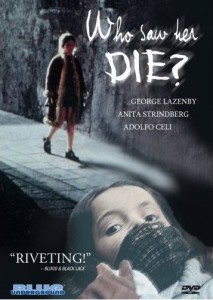Netflix streaming allows for an eclectic diet of movies. You can view not just Hollywood crap, but crap from all over the world. Recently, I’ve been watching Italian gialli films from the 1970s. Giallo (meaning “yellow,” a reference to the genre’s origins in a series of paperbacks with yellow covers) is a sub-genre of the crime thriller notable for its exceptional levels of violence. A giallo plot is typically a murder mystery with a few red herrings, gratuitous sex, and a chase sequence or two. In other words, hardly different than the pulp crime novels familiar to most Americans. But the lasting impressions of these films has less to do with the “whodunnit” plot mechanics than with the gore. Murder sequences are often long, bloody, and elaborate.
Of the four gialli that I watched, Profundo Rosso (Deep Red) was far and away the best. I’ll discuss it in my next post, but for now I’ll focus on three other films: The Black Belly of the Tarantula, Don’t Torture a Duckling, and Who Saw Her Die? Normally I’d give a spoiler warning, but these films are from the 70s, so deal with it.
.
The Black Belly of the Tarantula (1971)
Directed by Paolo Cavara
Starring Giancarlo Giannini, Ezio Marano, Barbara Bouchet, and Barbara Bach
Genre entertainment can be roughly grouped into three categories: works that fail to satisfy the bare minimum expectations of the genre, works that transcend the genre, and works that embody the genre so precisely that the details become blurry, and instead you’re left talking about tropes. As you’ve probably already guessed, The Black Belly of the Tarantula falls into the third category. It has a murder mystery – someone is murdering impossibly attractive women (including a Bond Girl). It has a detective (Giancarlo Giannini). It is extremely violent. And it is utterly sleazy and misogynistic.
Giallo, and the crime genre more broadly, is not known for its feminism. Women are objects, women are tramps, and women are targets. In the case of the first victim, she’s all three. The character (played by the gorgeous Barbara Bouchet) is on screen for little more than 20 minutes and half of that time is spent stark naked. The other half of the time is spent teasing her blind masseur, cheating on her husband, and then being terrorized and murdered. And I don’t mean anything as prosaic as being shot. The name of the film refers to a wasp that paralyzes tarantulas with its stinger and then plants its eggs in the tarantula’s abdomen. The killer uses a needle to inject the wasp’s venom into his victims’ spine and paralyzes them. He then rips off their clothes and slowly cuts them open with a knife while they’re still alive.
The filmmakers engage in the pretense that everyone is horrified by this brutality. But brutality, directed at women, is the whole point. The murder sequences are lengthy, gory, and devoted to the display of female flesh as it is slowly penetrated by the killer’s blade. While undeniably loathsome, the intense misogyny gives the murder scenes a demented energy that’s absent in the rest of the film. The tedious domestic scenes of detective and wife and the film’s convoluted plot are poor attempts to legitimize exploitation.
.
Don’t Torture a Duckling (1972)
Directed by Lucio Fulci
Starring Tomas Milian, Barbara Bouchet, Florinda Bolkan, and Marc Porel
Sometimes killing women just isn’t exploitative enough. Thank God for children.
Don’t Torture a Duckling is about a murderer who targets young boys in a small Sicilian village. There are suspects and red herrings everywhere. The killer could be the town idiot, the local witch, the overly-protective priest, or the big city harlot (Barbara Bouchet again). The police are worse than useless, and most of the detective work is done by a reporter, Martelli (Tomas Milian).
While Don’t Torture a Duckling has superficial similarities to The Black Belly of the Tarantula, the latter is nothing more than competent genre hackery with a dose of sexism. The former is a film with an actual point to make, namely that religion and superstition are terrible things. For example, one of the suspects is a gypsy witch (Florinda Bolkan) who confesses to the murder. But when the police ask her how she did it, she admits that she merely “cursed” the boys with voodoo dolls and has no idea how they actually died. The witch is not a killer but a pitiful joke, but that doesn’t save her from the superstitious townsfolk. In a scene reminiscent of medieval witch hunts, the fathers of the slain boys corner the witch and beat her to death in a gruesome sequence.
In contrast, the thoroughly modern reporter and the big city girl, Patrizia, are far more sympathetic. The treatment of Patrizia is notable in how it contrasts to treatment of women in The Black Belly of the Tarantula. Initially, Patrizia seems to be another giallo sexpot, teasing the young boys with her beauty. The film even hints that she might be the killer. But it turns out that Patrizia is neither a seductress nor a murderer – she’s just a harmless pothead who was banished to the country because of a drug arrest. The modern girl actually turns out to be a hero of sorts, and she even helps Martelli solve the mystery.
The murderer turns out to be the village priest, Don Alberto (Marc Porel), who was killing the boys to “protect” them from sexuality and ensure that they would go to heaven with stainless souls. While attempting to kill another child (his own sister!) by throwing her off a cliff, Alberto is instead pushed off by Martelli. This leads to an overdone death sequence where Alberto (actually a dummy that looks nothing like Marc Porel) slowly falls to his death as jagged rocks tear his face off, all the while flashbacks reveal his nonsensical motives.
Up with modernity, down with superstition! But the film’s point of view doesn’t survive scrutiny. Catholic priests have committed horrible acts throughout history, not least of which is the multinational child abuse scandal, but I can’t find any examples of a priest who actually murdered several children to help them avoid sin. Dying young to escape sin is simply not a Catholic obsession. Sin is unavoidable perhaps, but the penitent can always obtain forgiveness. So the filmmakers essentially invent a flaw in Catholicism that they can then throw off a mountain. One last point: the assertion that modern society is less violent than traditional society is ridiculous, especially in the country that invented Fascism (cheap shot, I know).
.
Who Saw Her Die? (1972)
Directed by Aldo Lado
Starring George Lazenby, Anita Strindberg, Adolfo Celi, Nicoletta Elmi, and Alessandro Haber
More kid killing!
Who Saw Her Die? is yet another story about a psycho killer who targets children (this time little girls instead of little boys). Franco Serpieri (George Lazenby) is an artist in Venice living apart from his daughter, Roberta (Nicoletta Elmi), and estranged wife (Anita Strindberg). When Roberta comes to visit, she is immediately targeted by a mysterious killer wearing a black dress and veil. Poor Roberta gets offed fairly early in the film, and Franco becomes an amateur detective to find out who murdered his daughter (because the police are, as usual, useless).
In most respects, Who Saw Her Die? is superior to the above two films. Venice proves to be an excellent locale for film noir. Aldo Lado turns the city of canals into a city of dark passages and winding alleys. The characters are a bit more developed than in the other gialli, and Lazenby puts in a decent performance as the grieving father. There are also a couple of wonderfully off-beat moments, as when Franco interrogates a man while playing a game of table tennis. And the score by Ennio Morricone (who also composed the score for The Black Belly of the Tarantula) is a trippy, addictive mix of rock and children’s choir. Unfortunately, the filmmakers never quite get a handle on how to incorporate the score into the film, and certain riffs such as the killer’s theme are overused.
The early scenes are kinda brilliant in a manipulative and evil way. Every time Franco leaves Roberta alone outside, the killer shows up and begins to close in. But just as the killer is about to grab Roberta, Franco returns in the nick of time, completely oblivious to the fact that he just saved his daughter. But then Franco leaves Roberta alone to play outside just a little too long, and the killer gets her. First message to parents: your child is being targeted by a serial killer at all times! Second message to parents: do not leave your child outside while you get a blowjob from your mistress. You’ll just suffer dramatic guilt afterward when your child’s corpse is fished out of the water. On the plus side, your guilt will move the plot forward.
As in Don’t Torture a Duckling, there are multiple suspects and red herrings. Suspects include an evil businessman, a child molesting lawyer, a priest … I won’t waste your time, of course it’s the priest. But it gets better! He’s not just a priest but a cross-dressing priest. According to the Psycho Rule, that multiplies the evil by a factor of four. The film chickens out at the end though, when it is revealed that the killer was only impersonating a priest. The filmmakers were likely worried about offending Catholics. Though I suspect they were not so worried about implying that priests are murderers (Don’t Torture a Duckling was released in the same year) and more worried about implying that priests are cross-dressers. Some insinuations are beyond the pale.
Perhaps if cross-dressers had their own country and a global institution with millions of adherents, filmmakers might think twice about portraying them as degenerate child-killers.









